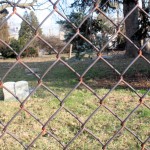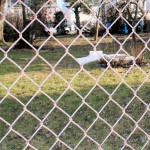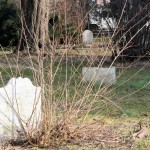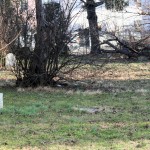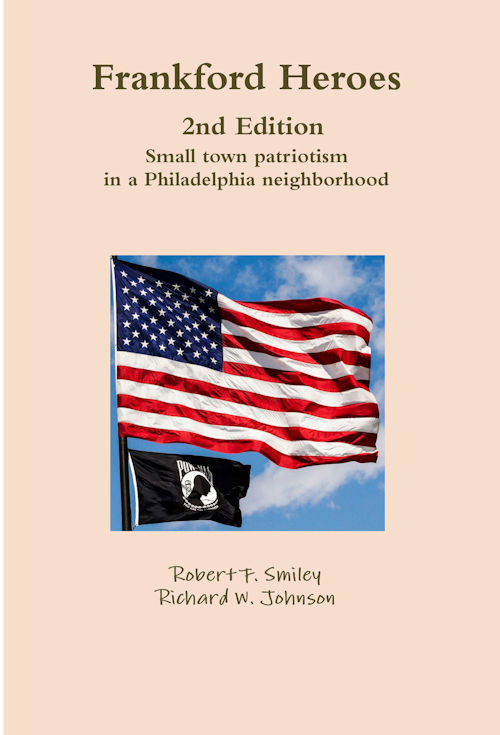Hidden in plain sight is a cemetery that appears to go way back. I’ve passed this location hundreds of times and never noticed it until I got a tip a few weeks go. I’m not sure if there is any documentation about who is buried there. Cemeteries are a part of history that is easy to overlook. Anybody have a clue?
Tag: History
Growing Up in Frankford Part 7
Continuation of Lyle (Corky) Larkin remembers:
Block Parties
Another of the many things I have found to be unique to Philly were the “Block Parties.” During the warm months you would find police barricades at either end of a given block, prohibiting any traffic. Usually on Saturday morning the inhabitants of this block would get together and start setting up tables in the middle of the street, complete with “oil cloth” table covers. (Mostly the white and red checkered kind.) Everyone would participate, bringing the “Specialty of the House” to his or her own table. There were more varieties of deviled eggs than I knew existed, backed beans, luncheon spreads, homemade pickles, fresh baked bread and some of the yummiest deserts I ever saw. There was either live music or someone would supply their “hi-fi” for playing records, but you could almost always count on somebody in that block being able to play some kind of instrument, including the “Washtub & Scrub-Board”. Sometime the block party would last through till Sunday evening.
Wash Day
Behind the row homes, were alleyways. Which was a narrow path that separated the back yards, just wide enough for a horse and wagon to go through. The curbs had a curved steel rail to protect it from the wagon wheels. For us kids, these alleys where a source of magic, for many of them interconnected and each turn had the promise of a new adventure. Walking down these alleys you would always see women hanging out their wash in the back yard. Mondays seemed to be the designated day for washing clothes. Women took great pride in hanging their wash out to show everyone how bright and white they got their laundry. There was almost an unspoken competition going on with the neighbors. You could be sure the whites passed a rigid inspection before they were hung up. I remember a bluing process that was used to make them look even whiter using ‘Unity Frankford Bluing’. We had a “Ringer” type washing machine down in the basement alongside a double compartment cement laundry tub, which sat on a metal frame. This tub had to weigh over two hundred pounds I remember some men broke it up with sledgehammers when they removed it. The washer was set next to these tubs so the water that was wrung out of the clothes as they passed through the hard wringers would go down the drain and not back into the washing machine. The agitator would go up and down instead of in a circular motion like the ones of today. The was a big red button on top of the wringers which was an emergency release in case you got your fingers too close while you were hand feeding the clothes through and the wringers caught your hand. For the toughest dirtiest clothes, there was always the “washboard.” This was not the fanciest of devices, it was simply a two foot by three foot wooden frame with a piece of galvanized ribbed metal that you placed upright inside of a tub and vigorously rubbed the piece of laundry up and down on until it came clean. For many, this was the only source of washing! It seemed like just one step above beating your laundry on rocks down at the river. There was no such thing as a dryer, so everything was hung out in the back yard to dry. Sometime in the winter the clothes froze on the line, so they had to be hung in the basement. The clothesline had to be changed often due to being out in the weather, it would get dirty and leave marks on the clothes. Clothes poles were used to prop up the lines and keep them from sagging in case there were too many heavy things on the line. Solid cast irons were used to make razor sharp creases in the shirts. We had a gas stove in the kitchen where my grandmother would heat the irons. She had several of these so while she was using one, the other was getting hot on the stove. The handles were removable so it was easy to switch those heavy irons once they cooled down.
Magic Radio
I can recall many Sunday nights, sitting in the living room on the floor and staring at the big RCA console radio. There was a small semi circle shaped dial in the middle towards the top with a yellow light in it. We would all sit there watching the radio listening to programs such as Jack Armstrong, Inner Sanctum, The Green Hornet, The Shadow, Charlie McCarthy, Burns and Allen, Amos and Andy, Sky King and finally, Walter Winchell with the news. This man could really sell the news; he made everything sound even more important than it was! “Good evening Mr. and Mrs. America and all the ships at sea. Let’s go to press.” That‟s how he would begin each program. I could go on and on with the list of programs that kept us glued to that set for hours each week. These were good times. These were family times. These were the times when you used your imagination to see things. These were the times before television.
To be continued…
The Day the Blob Attacked Frankford
The gang of 7 to 12 year old urchins we used to hang around with in the early 1960s in the Northwood section of Frankford, between Castor Avenue, Wakeling Street, Oakland Street, and Harrison Street, were definitely all “scientists.” We formed a science club which met in the basement of Nicky Macko’s house once a week. Nicky was the President — it was his family’s house, after all. Each of us would go to Frankford library at Frankford Avenue and Overington Streets whenever we could and borrow as many books as we could on how to do interesting science experiments at home. We’d study the books with rapt attention. Mostly we’d look for ways to turn junk into science experiments — much cheaper!
Electronics was the most fascinating science. Those were the glory days of vacuum tube technology. I was fascinated to discover that magnets, held close to the vacuum tubes filled with ionized gas emitting blue light, attracted the ionized gas to the magnet. I brought my AM radio, cover removed, to the next meeting of The Science Club, after I discovered that the ionized cloud in vacuum tubes was attracted to magnets, and plugged it in, and everyone “oooooooooooo’d” and “aaaaaaaaaaah’d” as they moved their magnets close to the vacuum tubes and saw the ion clouds in them move toward the magnet.
We discovered static electricity. If it was Fall or Winter, so that the air was very dry, we would recover the fluorescent tube-type bulb from someone’s trash (being careful not to break it — they explode), put on our best shoes, turn off all of the lights in the house, and walk across the room, shoes sliding on the rug, while we carried the fluorescent bulb in our hands. Lo and behold, the bulb would flash, all of the way across the room!
Then one of the guys — I forget who — discovered “exothermic reactions.” If you go into a closet with a roll of garden variety masking tape and close the door behind you, after your eyes get used to the darkness if you pull a piece of tape off the roll you will see light coming off the roll at the point where the tape separates from the roll as you pull it off.
In you similarly take Wintergreen Life Savers into a dark closet, and snap one of them in half with pliers, you will see the Life Saver give off a tiny flash of light.
The really annoying productions of The Science Club, from our parents’ perspective, were the ones requiring that strings or wires be strung between houses or trees outside.
We built “foxhole radios,” a kind of AM radio anyone can make out of junk. It uses a piece of wood, thumb tacks, insulated copper wire, a #2 lead
pencil, a safety pin of the type used for a baby’s diaper, a rusty razor blade, and the cardboard tube from the inside of a roll of toilet paper. The only non-junk item needed was a pair of headphones.
We would construct the radio, hang a 50 foot copper wire antenna between trees or homes (so that the ends of the antenna did not actually touch the trees or homes, but instead were held by string connected to trees or homes), run a lead from the antenna to the “radio,” run a separate wire from the “radio” to a pipe in the house, and hear 1210 AM in the headphones. No battery was needed — the antenna itself generated enough voltage for us to hear the radio program in the headphones.
We also connected houses with the tin can walkie-talkie sets — just ordinary tin cans in each house, with taut strings running from tin can to tin can, set up so that the strings touched nothing but the cans, and we would shout massages to each other through string. The vibrations of the sounds of our voices were conveyed through the string from one house to another.
And I guess the most annoying thing of all to our parents was our discovery of the home made telegraph. We’d run telegraph lines between houses, and telegraph Morse code to one another at night, and then run to the telephone to confirm the meaning of the message.
As we entered our pre-teen years, much to our parents’ dismay we became more skilled got at collecting junk for science.
Once I brought home a TV from someone’s trash.
My father sternly warned, “Don’t you DARE plug in that TV — it’s dangerous.”
Picturesque Frankford View
Hiddencity Philadelphia at the Globe
 There is a good story on Hiddencity Philadelphia about the Globe Dye Works with an update of where they stand in the massive renovation and repurposing of the complex. Take a look at this link.
There is a good story on Hiddencity Philadelphia about the Globe Dye Works with an update of where they stand in the massive renovation and repurposing of the complex. Take a look at this link.
There will be some events this year at the Globe that will be open to the public. If you have the time, it is well worth a look at this hidden treasure in our midst. Both sides of my family worked in the textiles mills in Frankford and the Globe is a significant part of that history.
